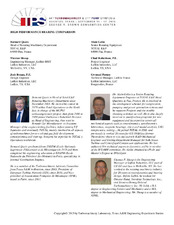| dc.contributor.other | Turbomachinery Symposium (44th : 2015) | |
| dc.creator | Ronan, Josh | |
| dc.creator | Shoup, Thomas | |
| dc.creator | Perney, Gwenael | |
| dc.creator | Robertson, Chad | |
| dc.creator | Quoix, Bernard | |
| dc.creator | Gelin, Alain | |
| dc.date.accessioned | 2017-09-09T14:06:21Z | |
| dc.date.available | 2017-09-09T14:06:21Z | |
| dc.date.issued | 2015 | |
| dc.identifier.uri | https://hdl.handle.net/1969.1/162180 | |
| dc.description | Lecture | en |
| dc.description.abstract | With the increasing demand for high performance gearboxes, larger, faster, more highly loaded bearings are requiring more oil and creating more heat than ever before. This means the lubrication systems must be larger to handle the increasing heat loads and oil demands. Offshore applications, in particular, are greatly affected due to space constraints and increased lubrication system size and cost. In an effort to reduce the oil flow and heat load requirements for the gearbox, experimental tests and field tests were performed with three different bearing designs. The designs were pressure dam, offset half, and tilting pad journal bearings. Data was acquired using a dedicated test rig that allows operation at and beyond design speeds and loads. Field test data was also collected from a full speed, full load string test of a turbo compressor drivetrain. This paper will present results of the experimental test data from these three bearings to assist in the selection of a design that will provide optimum performance for given operation conditions. | en |
| dc.format.medium | Electronic | en |
| dc.format.mimetype | application/pdf | |
| dc.language.iso | en | |
| dc.publisher | Turbomachinery Laboratories, Texas A&M Engineering Experiment Station | |
| dc.relation.ispartof | Proceedings of the 44th Turbomachinery Symposium | en |
| dc.subject.lcsh | Turbomachines | en |
| dc.title | High Performance Bearing Comparison | en |
| dc.type.genre | Presentation | en |
| dc.type.material | Text | en |
| dc.format.digitalOrigin | born digital | en |
| dc.identifier.doi | https://doi.org/10.21423/R1P35D | |


